Day 6 of the Blogging from A – Z Challenge and the word we’ve chosen is folklore!
Here is a list of 13 folkloric tales, that may have been involved in your family history!
All Hallows Eve
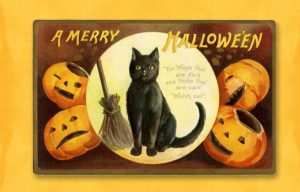
All Hallows Eve or Hallowe’en, as we know it, has many old, strange traditions that you probably didn’t know. At the end of October, the outside world begins to look dark and dreary as nature becomes dormant. Evil spirits and the souls of deceased family and ancestors were believed by many cultures to be wandering around at this time of year. The Welsh called this day “Nos Galan Gaeaf”, known as winter’s eve. The family ‘appeased’ their ancestors by placing food on a windowsill. They asked protection from the spirits that would do them harm and for them to not haunt the family.
Other strange customs that were used to keep the evil spirits at bay, were drawing double crosses, “…the putting of salt in the keyholes; the safe locking up of all the domestic and farmyard animals; the killing of a cockerel and hanging off its tail feathers on stable doors”, as this vintage postcard shows;
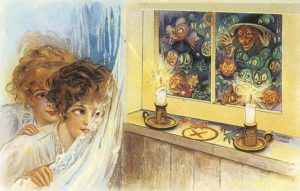
Young women also often used mirrors which were told to reveal their future lover. In some instances, if the maiden was fated to die before she was wed, a glimpse of her future husband’s face would be shown.
Other games played to determine future prospects included apple bobbing. Seizing an apple in one bite was an indication of good fortune.
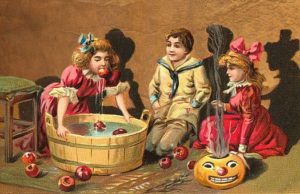
Old traditions were adapted into the ones we know today, Hallowe’en still remains a particularly spooky time for children of all ages.
Brownies
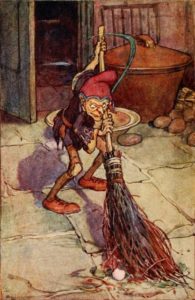
This, unfortunately, has nothing to do with those delicious chocolatey baked goods we love to eat. A brownie or broonie (known in Scotland) is a household spirit that is said to only come out at night when the owners of the house are fast asleep, and perform various chores. The owners of the house must leave offerings to the spirit, such as a bowl of milk, usually by the hearth. “Brownies are described as easily offended and will leave their homes forever if they feel they have been insulted or in any way taken advantage of. They are usually described as ugly, brown-skinned, and covered in hair. In the oldest stories, they are usually human-sized or larger. In more recent times, they have come to be seen as small and wizened. They are often capable of turning invisible and they sometimes appear in the shapes of animals. They are always either naked or dressed in rags. If a person attempts to present a brownie with clothing or if a person attempts to baptise him, he will leave forever.”
Chime Hours
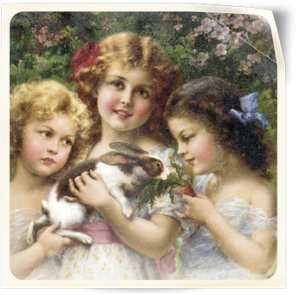
Chime Hours is said to have originated in the north of England and refers to one of the several myths related to the birth of a child. The story behind this piece of folklore is that those who are born during certain hours of the day or night gain special abilities. These supernatural abilities range from being able to see and communicate with ghosts and faeries, having complete control over animals, being musically gifted, and having the power to cure ailing animals and plants. Children with such influences are known as ‘Chime Children‘.
Dwarf

In Germanic mythology, a dwarf is a human-shaped entity that dwells in mountains and in the earth and is variously associated with wisdom, smithing, mining, and crafting. Dwarfs are sometimes described as short and ugly.
Emere
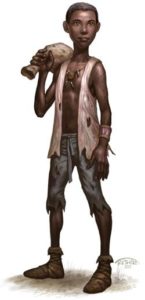
An Emere, in traditional Yoruba culture, is a child who can travel between the spiritual and physical world at will. It is said to be impatient, wanting the best of heaven and Earth. Usually considered an attractive female with seductive powers, an Emere is a spirit in disguise, misrepresenting death as life, and is clever enough to disguise her objectives. Believed to be more powerful than witches, they most often die on a particular day of joy. Such as wedding days, the birth of their first child, etc. depending on the degree of happiness the event might cause.
The Flying Dutchman
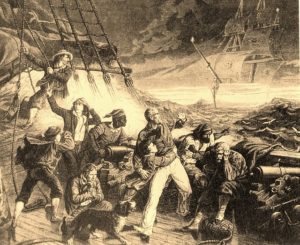
As the famous opera by Richard Wagner goes, legend tells of the fearsome Flying Dutchman, cursed to sail the seas until he finds a woman who will love him until death…
In 1795, sailors told a story of a Dutch ship that got lost at sea during a horrendous storm. The same ship later wrecked other ships in bouts of ghastly fog. This was the result of Captain Bernard Fokke’s behaviour: he was known for the “devilish” speed on his trips from Holland to Java. Some said that Fokke was aided by the Devil…
Another version of the legend starts in 1641 when a Dutch ship sank off the coast of the Cape of Good Hope. The trip to the Far East had been successful and the ship was on its way back home to Holland, so Captain Van der Decken was pleased… and failed to notice the dark clouds looming. Only when he heard the lookout scream in terror, he did realise they sailed straight into a heavy storm. Van der Decken and his crew battled for hours to get out of the storm, but then they heard a sickening crunch: the ship had hit a rock and began to sink. As the ship plunged downwards and the captain knew death was approaching, he screamed out a curse: “I will round this Cape even if I have to keep sailing until Doomsday!”
The Green Children of Woolpit
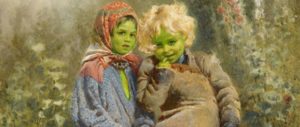
The legend of the green children of Woolpit concerns two children of unusual skin colour who reportedly appeared in the village of Woolpit in Suffolk, England, sometime in the 12th century.
A boy and his sister were found by men working their fields during harvest time near some ditches that had been excavated to trap wolves at St Mary’s of the Wolf Pits (Woolpit). Their skin had a green hue, their clothing unfamiliar, and their speech was unintelligible to the men. They were taken to the village, where they were eventually accepted into the home of a local landowner.
The boy later became sick and soon died, while the girl remained in good health and eventually lost her green tinged skin. She learned how to speak English and was later married to a man in the neighboring county of Norfolk. According to some accounts (which have not been verified), she took the name Agnes Barre, and the man she married was an ambassador of Henry II. She learned how to speak English, and later relayed the story of her and her late brother’s origins.
The girl reported that she and her brother came from the Land of Saint Martin, where there was no sun, but a perpetual twilight and all the inhabitants were green like them. She described another luminous land that could be seen across a river. She and her brother were looking after their father’s flock, when they came upon a cave. They entered the cave and wandered through the darkness for a long time until they came out the other side, entering into bright sunlight, which they found startling. It was then that they were found by the men tending to the fields.
One theory from this account is that the children were suffering from Hypochromic Anemia, originally known as Chlorosis, coming from the Greek word ‘Chloris’, meaning greenish yellow. The condition is caused by a very poor diet that affects the color of the red blood cells and results in a noticeably green shade of fair skin. In support of this theory is the fact that the girl is described as returning to a normal color after adopting a healthy diet.
With regards to the description of the strange land, Paul Harris suggested in Fortean Studies 4 (1998) that the children were Flemish orphans, possibly from a nearby place known as Fornham St. Martin, which was separated from Woolpit by the River Lark. A lot of Flemish immigrants had arrived during the 12th century but were persecuted under the reign of King Henry II. In 1173, many were killed near Bury St Edmunds. If they had fled into Thetford Forest, it may have seemed like permanent twilight to the frightened children. They may also have entered one of the many underground mine passages in the area, which finally led them to Woolpit. Dressed in strange Flemish clothes and speaking another language, the children would have presented a very strange spectacle to the Woolpit villagers. Source: thenightsky.org
Hag
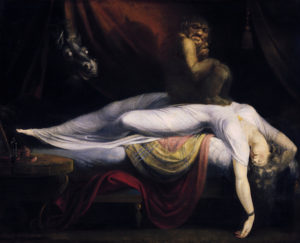
A ‘Hag’ is depicted in medieval folklore as a ‘wizened’, ugly, old woman or a fairy or goddess disguised to appear as one. Often seen as malevolent, in English and Anglo Northern American folklore the ‘Old Hag’ was a nightmare spirit that sat on a sleeper’s chest and sent nightmares to the dreaming sleeper. When they woke, the subject would be unable to move or breathe for a short period of time. A condition we have now identified as Sleep Paralysis.
Many tales about hags do not describe them well enough to distinguish between an old woman who knows magic or a supernatural being. In Slavic folklore, Baba Yaga was a hag who lived in the woods in a house on chickens legs. She would often ride through the forest on a mortar, sweeping away her tracks with a broom. In Irish and Scottish mythology, the cailleach is a hag goddess concerned with creation, harvest, the weather, and sovereignty. In partnership with the goddess Bríd, she is a seasonal goddess, seen as ruling the winter months while Bríd rules the summer.
I is for Imp
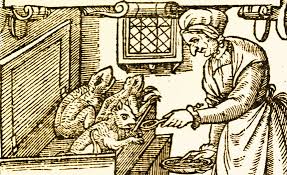
An Imp is a mythological being, similar to that of a fairy or demon described as causing of mischief rather than being seriously threatening. They are known in Germanic folklore as ‘lesser demons’, who were not seen evil or harmful to humans. Unlike in old English etymology, particularly in the 16th century, imps were used in expressions such as “imps of servants” and “imps of the devil. Thus, by the 17th century it came to mean a small demon, or a familiar to a witch.
Imps were often portrayed as lonely little creatures always in search of human attention. They often used jokes and pranks as a means of attracting human friendship, which often backfired when people became tired or annoyed of the imp’s endeavors, usually driving it away.
Even if the imp was successful in getting the friendship it sought it often still played pranks and jokes on its friend either out of boredom or simply because this was the nature of the imp. This trait gave way to using the term “impish” for someone who loves pranks and practical jokes.
Jorōgumo
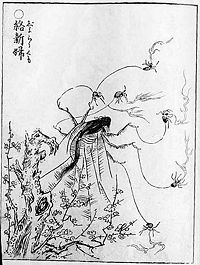
A Jorōgumo is a type of ghost, creature or goblin in Japanese Folklore. It is frequently recalled as a woman-spider that can shapeshift into a beautiful woman.
Krampus
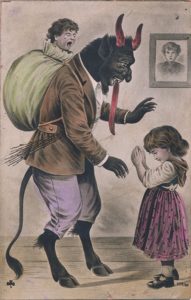
Krampus, the half goat, half demon, terrifying beast is derived from the German word krampen meaning claw. The legend is part of a centuries-old Christmas tradition in Germany, where Christmas celebrations begin in early December. Krampus was created as a counterpart to kindly St. Nicholas, who rewarded children with sweets. Krampus, in contrast, would swat wicked and ungrateful children, stuff them in a sack, and take them away to his lair.
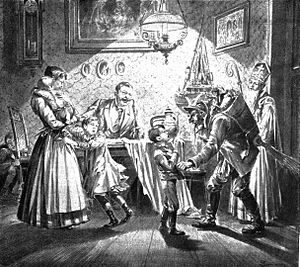
According to German folklore, Krampus shows up in towns, sometimes with Saint Nicholas, on the night of December 5, known as Krampusnacht, or Krampus Night. The next day, December 6, is Nikolaustag, or St. Nicholas Day. On this day, children look outside their door to see if the shoe or boot they’d left out the night before contains either presents (a reward for good behavior) or a rod, or piece of coal (bad behavior).
La Llorona
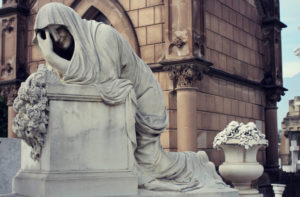
La Llorona or ‘Weeping Woman’, its translation, in Mexican folklore is the ghost of a woman who drowned her two children in a river and cries while she is looking for them, causing misfortune for those who see or hear her.
Stuck between the land of the living and the dead, she spends eternity looking for her lost children. La Llorona kidnaps wandering children at night, mistaking them for her own. She begs the heavens for forgiveness and drowns the children she kidnaps. It is said that if her cries sound near, she is actually far away, and if they sound distant, she is actually very close. The tale is told to many children in Latin America to scare children from staying out too late.
Written by Rhianna Selkridge-Carty
Although these weird, wonderful and terrible tales didn’t actually send anyone to their grave. We’re sure, you’ll want to know about its history! Read our next blog G is for Graveyard.

